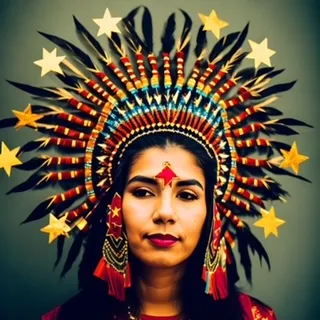Power of Shapes in Conveying Emotion and Meaning in African Cultures
Shapes hold great significance in many African cultures, and are often used to convey complex ideas and beliefs.
Discover more textile symbolism and quilt traditions in the African Quilting & Textile Crafts Hub .
In African cultures, shapes play a crucial role in conveying emotions and meanings. The use of shapes can be seen in a wide range of artistic expressions, from traditional crafts and textiles to contemporary art and architecture. Each shape has its own unique significance, and the combination of different shapes can create a complex web of meanings and emotions.
Shapes can evoke feelings of joy, sorrow, anger, and hope, and can communicate important cultural values and beliefs. In this way, shapes are not just aesthetic elements, but powerful tools for storytelling, expression, and communication in African cultures. In this article, we will explore the power of shapes in conveying emotion and meaning in African cultures, and how they are used in various forms of artistic expression.
In countless works of written and visual African creativity, shapes are used to express spiritual and philosophical concepts, tell stories, and depict the natural world. African designers and artists often use shapes intentionally to create specific emotional responses and convey meaning through their work.
For example, the circle is a powerful symbol of unity, completeness, and wholeness in African culture. The spiral is a symbol of growth and the square represents stability.
The use of shapes in African culture is a rich and complex tradition that reflects the deep spiritual and philosophical beliefs of African people. African cultures, shapes hold immense importance and are utilized to communicate intricate ideas and beliefs.
Many African cultures use geometric shapes such as triangles, circles, and squares to represent different aspects of life.Shapes can have a profound impact on human emotions, and are often used intentionally in art, design, and architecture to evoke specific feelings and responses.
For example, the circle is often used to represent unity and the cycle of life, while the triangle may represent the trinity of mind, body, and spirit.
The Power of Shapes in Conveying Emotion and Meaning in African Art, architecture and textiles.
African masks and sculptures often feature abstract shapes and forms that convey deeper meanings. These shapes may represent different spirits or deities, or may be used to symbolize different aspects of human behavior or emotions.
African textiles often feature geometric patterns and shapes that convey cultural and spiritual meanings. For example, the Adinkra cloth from Ghana features symbols that represent different virtues and values.
Many African architectural styles feature geometric shapes and patterns, which may represent different aspects of nature or cultural beliefs. For example, the mud houses of Mali often feature intricate patterns that are both beautiful and functional, providing insulation from the heat and cold.
There are many shapes that hold special meaning in African culture. Each shape can have different interpretations and significance depending on the context and culture.
 |
| Spiral are a symbol of growth. |
The circle is a powerful symbol of unity, completeness, and wholeness in African culture. It represents the interconnectedness of all things and the cyclical nature of life.
The triangle is often used to represent the trinity of mind, body, and spirit, as well as the past, present, and future. It can also symbolize stability, strength, and balance.
The square represents stability, grounding, and the four cardinal directions. It is often used in African architecture and design.
The spiral is a symbol of growth, transformation, and evolution. It represents the journey of life and the cyclical nature of change.
The cross is a symbol of spiritual and physical protection and is often used in African religious and spiritual practices.
The zigzag represents the journey of life and the ups and downs we all experience along the way.
The diamond is a symbol of strength and endurance, as well as the interconnectedness of all things.
Each shape can have different interpretations and significance depending on the context and culture. The use of shapes in African culture is a rich and complex tradition that reflects the deep spiritual and philosophical beliefs of African people.
In African cultures, shapes are used to convey a wide range of emotions and meanings in various forms of artistic expression. Each shape holds its own unique significance and can be combined with others to create complex webs of meaning.
Shapes can evoke feelings such as joy, sorrow, anger, and hope and are a powerful tool for storytelling, expression, and communication in African cultures. From traditional crafts and textiles to contemporary art and architecture, the power of shapes is seen throughout African culture.
This article explored the significance of shapes in African culture and how they are used to convey emotion and meaning in various art forms.
Did you know?
Some researchers believe that humans may have an evolutionary preference for circular shapes because they are often found in natural objects such as fruits, flowers, and the sun. Our brains may have developed an affinity for these shapes as a way of recognizing and navigating the natural world.
Continue exploring patterns + meaning inside the African Quilting & Textile Crafts Hub .



























